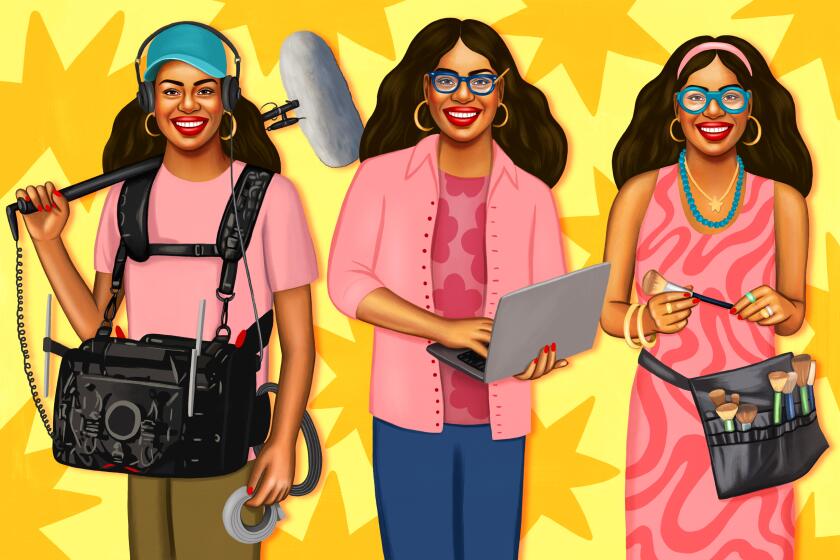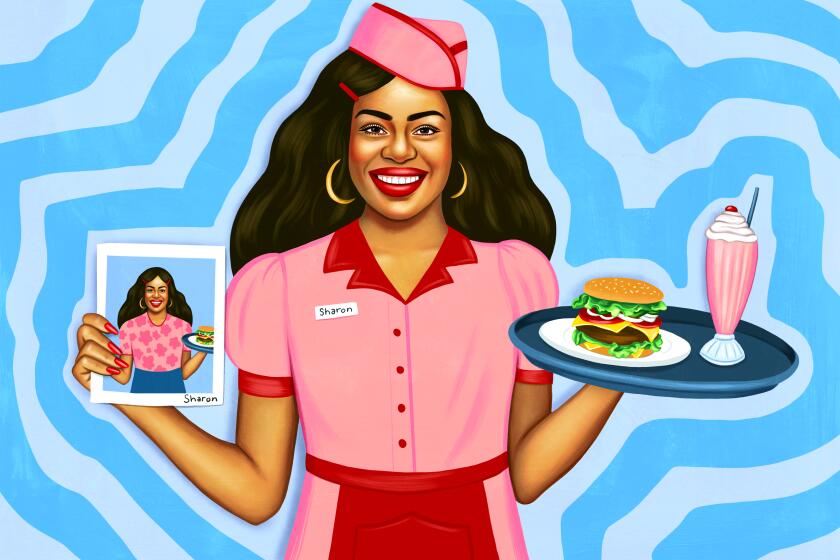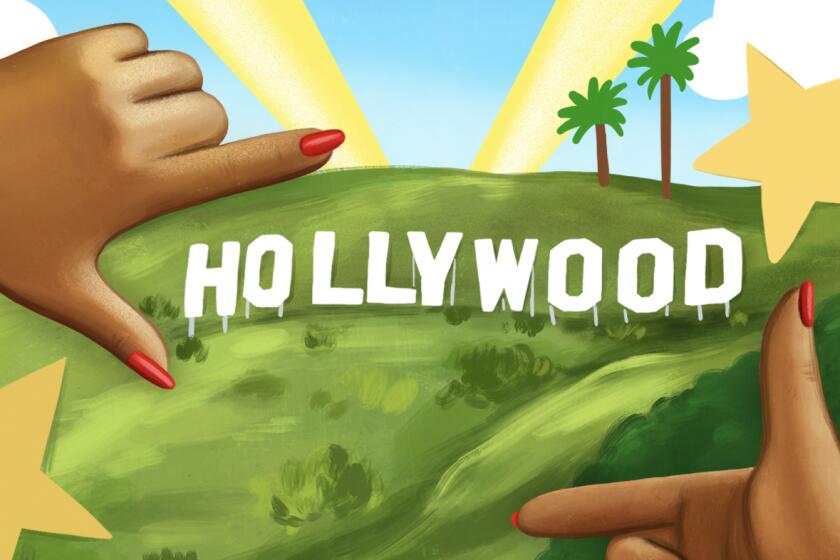Explaining Hollywood: How to get a job in practical special effects

- Share via
During the economic recession of the 1980s, Fon Davis — now famous for his miniature model designs on films such as “The Nightmare Before Christmas” and the “Star Wars” prequels — had just graduated high school and was working at a McDonald’s in Eugene, Ore.
With less than $50 to his name, a tote bag and a dream, he quit McDonald’s and paid a Deadhead to drive him to Berkeley, where he boarded a BART train to San Francisco and was prepared to sleep on the streets.
He ended up staying in the walk-in closet of a punk rock band’s digs and finding work in carpentry before bouncing from scenery shop to scenery shop — where various set pieces are fabricated — and eventually booking his first studio gig as a set builder at Colossal Pictures.
After more than three decades as a practical special-effects artist — building robots, spaceships, stop-motion landscapes and other miniature marvels for such blockbuster projects as “The Matrix” and “The Mandalorian” — Davis now runs his own Los Angeles production company, Fonco Studios, where he helps cultivate rising talent.
Practical special effects are optical enhancements — extreme weather simulations, explosions, miniature model displays and creature makeup, for example — that are physically created on set and filmed in-camera during production. These are not to be confused with visual effects, which are typically generated with a computer and added to the frame in post-production.
Growing up, Davis, who is a first-generation Vietnamese immigrant, had read in magazines about pioneering special-effects artists of Asian descent — Larry Tan, Ease Owyeung and Greg Jein — whose success in the field inspired him to carve out space for himself in an overwhelmingly white-, male-dominated craft.
But by the time he landed his big Hollywood break, Davis wasn’t interested in standing out.
“I’ll be honest. I didn’t want to talk about it because I wanted to sell myself as an established professional and blend in with everyone else,” he said. “I would just avoid the topic of ... my origins and where I came from. But now I feel like it’s important to actually say it. ... I think about the power of seeing those three Asian guys in magazines when I was a kid, you know?”
Davis and four other special-effects professionals — Maggie Anne Goll (“Bill & Ted Face the Music,” “Diary of a Future President”), J.D. Streett (“Men in Black,” “Entourage”), Todd Masters (“True Blood,” “Legion”) and Sandy Stewart (“Euphoria,” “Silicon Valley”) — spoke with The Times about their experiences breaking into the business and offered insight about how you can do the same.
What does a TV writer do? How do you become one? How do you move up? How much money can you make? The L.A. Times is explaining the entertainment industry — here’s what you need to know about being a TV writer.
Who becomes a special-effects artist?
Because it’s such a broad term, a variety of personalities and skills are found among special-effects artists.
But there are a few essential qualities almost all of them share.
A jack of all trades: Masters said the best special-effects artists “are the ones that have the most diverse skill sets” and can be relied on to complete any task that’s thrown at them. Because of this expectation, Goll added that it’s generally helpful to have “well-rounded mechanical knowledge and just have some skill working with your hands — being able to get dirty.”
A quick thinker: Above all, special-effects artists are highly adaptable, with the ability to “switch gears quickly,” “be flexible” and “go with the flow,” Stewart said. Because “there’s definitely gonna be a monkey wrench thrown into what you plan” on any given day.”
A team player: Big egos and negativity have no place in special-effects departments, where hordes of talented, creative minds spend hours on end together — often late into the evening and early morning — all in pursuit of a singular vision.
“No one wants to work with someone who’s got a bad attitude,” Streett says. “I’ve run into maybe five people in my 30-plus-year career that were so talented that they could have a bad attitude. And people with a good attitude but less skill will get hired before people with a bad attitude and greater skill.”
We Can Teach You That
How to build a career in Hollywood
Join Times reporters Anousha Sakoui and Wendy Lee, as well as Bree Frank, vice president of physical production for unscripted TV at Hello Sunshine, and Phillip Sun, the president and co-founder of the management company M88, for a virtual webinar on careers in the entertainment industry. We’ll discuss the state of Hollywood jobs, how aspiring entertainers can get a foot in the door, and take your questions.
When: Tuesday, Aug. 10, 6 p.m. Pacific time
Cost: $10 for Times subscribers; $20 for non-subscribers
Tickets: Sign up on Eventbrite
What’s on your mind? Please let us know in advance of Aug. 10 about your interests and most pressing questions about working in Hollywood. Share your questions here.
How do you get started?
Trade school: Education with a laser focus on specific crafts has become an increasingly common gateway into special effects. Los Angeles Trade-Technical College, the Otis College of Art and Design, the Gnomon School of Visual Effects, Games & Animation and the Stan Winston School all offer niche courses and training applicable to the moviemaking business. Universities with top film programs, such as USC, are also options.
Engineering: A background in engineering — whether educational or experiential — can translate well to a career in special effects. Streett, for example, graduated from the University of Missouri with a degree in electrical engineering. Goll was raised by two chemical engineers.
Carpentry: Working as an apprentice in carpentry or another special-effects-related discipline is a great way to hone your skill set and build a portfolio, which you’ll need when applying for coveted positions at scenery shops and production studios. Pro tip: Welders are in extremely high demand at the moment, if you’re not sure which craft to explore.
Production assistant: Some special-effects experts, such as Stewart, get their feet wet in the industry as production assistants. While shouldering much of the heavy lifting on set, PAs have an opportunity to learn key tools of the trade and form meaningful connections with special-effects coordinators with future hiring power. Masters started out as “a complete peon” on the set of 1986’s “Big Trouble in Little China” before rising through the ranks as a makeup artist.
The first step in your Hollywood career shouldn’t be paying L.A. rent. Here’s how to take your first steps toward a career in the entertainment industry, according to experts.
What are the career paths?
Goll, who left a career in law to begin working in practical special effects five years ago, and Stewart, who entered the field more than 30 years ago, described near-identical routes to the top of the special-effects ladder.
Most newcomers are initially hired as prop makers, tasked with fabricating and assembling various set pieces and expanding their repertoires in the process.
After logging thousands of hours practicing woodwork, welding, blueprint design, breakaway glassmaking and myriad other “special skills” — documented and signed by a supervisor — prop makers can graduate to prop shop, where they accumulate even more talents and certifications to add to their resumes.
To become eligible for membership in the International Alliance of Theatrical Stage Employees’ Local 44, which covers special effects and other crafts, one must spend at least 30 days working for a union project on a permit as a prop maker or under the supervision of a special-effects foreperson.
Fast forward another four years or so, and seasoned prop shoppers are given a chance to be tested on their knowledge via a two-pronged written and oral exam.
In addition to evaluating each person’s budgeting and organizational abilities, the written portion consists of story problems that require test takers to apply what they’ve learned to real-life scenarios and describe, in detail, how they would execute certain effects.
Then — before a council of “older, experienced effects guys who are all judging you” — candidates must identify various tools and their purposes, as well as answer a barrage of questions on the spot about how they would approach different projects and potential setbacks that might arise during production.
“It’s mostly a test of your nerves — not just your knowledge — at that point,” says Goll, who has yet to take the exam but has experienced it vicariously through her partner, who recently passed his.
“Like, can you handle the pressure? ... I’ve heard it’s pretty nerve-wracking.”
Once you’ve passed both the written and oral assessments, Goll said, “you can lead a show. You can be the big dog on top” as a special-effects coordinator.
“It doesn’t mean you know everything,” she added. “It just means that, at that point, you know ... who to hire and who to call to get the stuff.”
Stewart, who has helmed special-effects departments on multiple high-profile projects for HBO, TBS, Fox and more, failed her oral exam the first time she took it.
“My feelings were hurt,” she said. “I was kind of angry for a while about it because I thought I was qualified, and it took me a little while to come around.
“I pushed myself to learn as much as I could learn and to help as much as I could help and not just come in ... for the check. I came in to really learn. And that worked out.”
For many people who pursue entertainment as a career, it takes years to get yourself to where you are making money from your creative work. For making money in the meantime, there’s always waiting tables. But more and more people are turning to platforms like TikTok, Twitch and Patreon.
How do you make money as a special-effects artist? (And what kind of money?)
Like much of the industry, special effects is a “wildly erratic business,” in which professionals frequently jump from gig to gig — some of which pay more than others.
“I’ve worked for some of the biggest studios ever, but it’s rare that you work at the same place for long durations of time, so it’s kind of a nomadic existence,” said Davis, whose employment history includes stints with Disney, Lucasfilm and Paramount.
“It’s not for the faint of heart. ... If you’re like me, and you love variety and you love challenges and you love the way you feel at the end of every project because it was hard, then you’re cut out for this. But if you’re looking for stability, if you’re looking for predictability, you go work for the government. You don’t work in entertainment.”
On low-budget films and TV shows, prop makers with union representation can expect to make anywhere from $17 to $25 an hour, plus overtime, according to Stewart.
Generally, yearly income for special-effects artists ranges from about $40,000 to more than $100,000 — depending on the quantity and type of jobs completed — with full benefits for union employees.
“It’s so broad,” Masters says. “It’s not like there’s a book rate. But ... you can still make some OK money. It all depends on how creative you are and how many different streams of revenue you can bring in.”
Those looking to make some cash on the side might choose to lease or rent “effects packages” full of professional equipment to various productions, or sell independent artwork.
“Making money that [doesn’t] require you to physically be there is great if you can get it,” said Streett, who has lent trucks full of effects gear to sets.
“But you need to have the right personnel that are going to be operating that equipment.”
Send the L.A. Times your questions about breaking into and working in the entertainment industry.
How has the field changed in 20 years?
In the competitive world of special effects, “today’s miracle is tomorrow’s quota,” Streett says — meaning that the landscape of the industry has transformed radically and consistently over the years because of constant innovation.
“We’re always evolving to change with whatever technology there is,” Davis says. “It’s like you’re a student for your entire career. You have to constantly be studying and learning ... about the newest, latest, greatest technology.”
Of course, one of the most significant areas of technological advancement over the last few decades has been computer generated imagery (CGI), which has dramatically expanded the realm of possibility for the visual- and special-effects departments.
A standard explosion rigged by special-effects technicians, for example, can now be augmented via CGI in post-production to appear grander or closer to camera. A miniature model designed and built by special-effects artists can be scanned into a computer and enlarged on-screen by the visual-effects team after filming — no camera tricks necessary.
“It blends the worlds of the purely computer generated to reality,” Stewart says. “It has made projects more ambitious, because now they can visualize doing things larger, more involved. And our work is critical because it gives the actors and it gives the sets a reference ... things that they can see, they can feel, they can hear.”
Multiple special-effects experts emphasized the recent importance of developing a level of proficiency in the virtual sphere, as well as the practical one, to account for the increasing hybridization of the two disciplines.
“To really understand the broad art of film effects, you really need to have an understanding of computer graphics and visual effects and camera — all the post-production side of it — as well as the production side of it,” Masters says. “You need to be able to manage a lot of different skill sets and speak a lot of different ways to different artists and filmmakers.”
Rejection and uncertainty are part of working in Hollywood, but joy, creativity and fun can be too. Here’s how to manage your mental health.
What advice do pros hear that is wrong?
Because the special-effects business is such a distinctly unpredictable, high-stakes environment, there are some professional platitudes that don’t apply.
“If you don’t enjoy your work, you shouldn’t do it.” Making movie magic can be hard, often grueling work — and that’s OK, Davis says. As long as you know what you’re getting yourself into.
“You shouldn’t lower your quality of life as a sacrifice for your work,” he says. “That is true to a certain extent, but there’s balance in everything. Sometimes you have to do the really crappy work to get to the really good, fun parts of your work, and so managing your expectations is an important thing.”
“Never work for free.” Again, Davis says, this message is admirable and indisputable in theory, but there are some exceptions.
“If you are on a student film, you’re going to be working for free,” he says. “Because you need that experience. I would say: Never work for free if the person has money. Don’t let people take advantage of you.”
“You can’t say no.” Not only can you say no to things you disagree with — often in special effects, you must say no when presented a concept that could cause a potential time crunch or safety hazard, Goll says.
“You can absolutely tell someone, ‘No, you can’t do that,’” she adds. “But you have to be able to speak confidently on it and ... explain why. And that’s knowing your budget, that’s knowing your capabilities, that’s knowing ... what resources you have at your disposal to do the job. I hate those people who say you have to say yes.”
What’s some good advice?
“Listen and learn.” Too often, creative folks can become so fixated on their own methods, they fail to consider that “there are so many ways to do something right, and it never hurts to learn a new way,” Goll said. When they’re starting out, “far too many people talk ... rather than listen,” Streett added. “It’s a learning period.”
“Fail in private.” Don’t be afraid of failure, Davis says, but you can avoid failing in public by tinkering with new technologies and materials in the privacy of your own home. That way, by the time he arrives on set, “no one’s gonna see me make the mistakes, because I’ve already made them.”
“Make a five-year plan.” It’s more than likely your vision of the future won’t go exactly according to plan — especially in a field as volatile as special effects — but it’s helpful to outline some goals.
“A good way to learn about where you want to go is to basically vocalize ... what do you not want,” Masters says. “That’s usually easier for people to kind of internalize and figure out.”
Women, “keep pushing.” Goll estimates that she’s one of about six “younger women” coming up in the special-effects industry right now. But it doesn’t have to be that way.
“There really aren’t many of us,” she says. “I still get asked who my dad is, and ... I want to laugh and say back, ‘Well, who’s yours?’ Because I worked my butt off to get here. ... You just gotta keep kicking a—, and you have to have the passion for it.”
Read more of The Times’ guide to working in Hollywood.
Careers in the entertainment industry can be mysterious for those just starting out, and even for those working in the business. The Los Angeles Times brings you explainers and advice for starting and building your career in Hollywood.
More to Read
Inside the business of entertainment
The Wide Shot brings you news, analysis and insights on everything from streaming wars to production — and what it all means for the future.
You may occasionally receive promotional content from the Los Angeles Times.

















